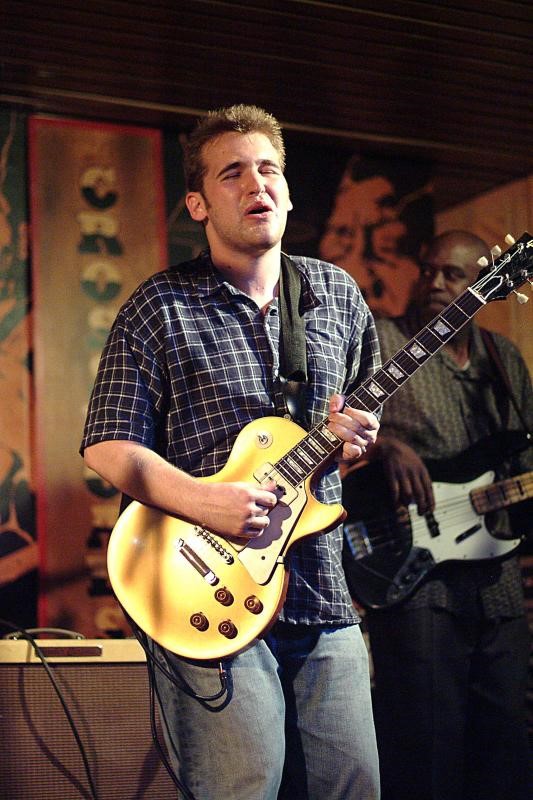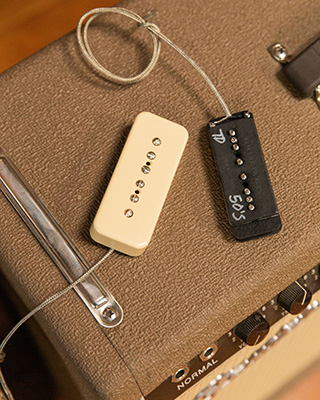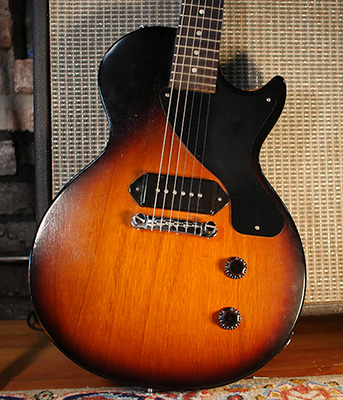By Mike Wohl
Sean Costello made a name for himself and left an indelible mark on the blues world by virtue of his fiery instrumental prowess and workman-like dedication to his craft, honing his chops before his career was tragically cut short by his passing in 2008. Drawing inspiration from the sounds pioneered by Freddie King, Hubert Sumlin, Otis Rush, and so many other legends from the 1950s and ‘60s heyday of electric blues, Sean’s dynamic playing and searing tone moved hearts and minds, inspiring audiences every time he plugged in.

His approach to playing was innovative and lyrical, with an undeniable force behind it. Watching videos of Sean’s live performances, it’s impossible to ignore his passion and charisma—even on the humblest of stages. And similarly, one cannot overlook the beautiful Les Paul Goldtop often seen in his hands, seemingly an extension of Sean himself. This particular Goldtop, a 1954 model, was the source of inspiration for a set of pickups that Jason Lollar built for Sean – what we call Lollar ‘50s Wind P-90s.
For decades we’ve been known for our “Standard” P-90s (we don’t actually refer to them as “Standard”—rather they are simply called “P-90 Soapbar” and “P-90 Dogear”—but we’ll do so in this article to differentiate them from the ’50s Wind P-90). We’re frequently asked what sets our ‘50s Wind P-90 apart from the Standard P-90 we make. There seems to be an expectation that our ‘50s Wind will sound like other vintage-era P-90s—and it does. Well, sort of. Let me explain.
In the 1950s there really was no “standard” voicing for P-90s—at least none that was consistent from one pickup to the next. Production standards were different back then, and pickup quality and tone varied considerably. Much of what we do here at Lollar is take the best examples of vintage pickups we can find, faithfully recreate their tone, and apply stringent quality standards to their production. And that’s exactly what we did with both our Standard and ‘50s Wind P-90s. Both models are voiced like vintage P-90s. It’s just that their voicings are based on different vintage versions.

To most players, the classic P-90 voice is one that is full sounding and midrange-focused, and somewhat aggressive even for a vintage-style pickup. They’re known for their excellent breakup and punchiness, with a tone often described as grinding or gritty. That pretty much sums up the tone you get from Lollar Standard P-90s .
Our ‘50s Wind P-90 has a much different sound than our Standard P-90. It was voiced to sound as close as possible to the set of Soapbar P-90s in Sean’s Goldtop. The tone of his pickups had some characteristics that made them unique when compared to other examples, even from a similar era.
“Players looking for more definition and less breakup from their P-90s often find the ‘50s Wind to be an excellent choice.“
Compared to most P-90s—including our Standard P-90—we designed the ‘50s Wind P-90s to be brighter without being harsh, and to have lower output without seeming weak. The treble content and clarity present in these pickups almost seems like a burlier version of Strat pickups, having less in common with many other P-90s than with brighter Fender-style single-coils. These pickups have excellent note definition and articulation and compress less readily than other P-90s. They are touch sensitive, and almost cross into twang territory at times. They could be said to be less raw than most P-90s, without seeming subdued – they truly offer their own thing.

sounding guitars like this Les Paul Jr.
The Lollar ‘50s Wind P-90s are a perfect fit for players working in a 1950s and 1960s electric blues idiom, sounding just like the originals. But importantly, they’re very versatile pickups, and are not limited to being part of a “character sound” for vintage-style blues players. Players looking for more definition and less breakup from their P-90s often find the ‘50s Wind to be an excellent choice. They’re also very well suited to bringing out clarity in darker sounding guitars, particularly slab mahogany style guitars like Les Paul Specials or Juniors. Their clarity and note separation can make them a good fit for fingerstyle or jazz guitar, or for players simply looking for a little less aggression or grind.
Sean and his Goldtop had a reciprocal relationship; his passion and talent brought the best out of the instrument, which in turn inspired and gave voice to a truly meteoric musician. The collaboration between Jason and Sean to replicate these pickups was the result of multiple versions, revisions, and late-night conversations, with Sean keeping in touch via phone to weigh in on the prototypes—even while on the road . Ultimately, the mutual admiration and respect for craft between Jason and Sean along with the Lollar quality and attention to detail resulted in the Lollar ‘50s Wind P-90, a pickup we are proud to continue to offer as a tribute to a legendary player gone far too soon.
We encourage you to make a donation to The Sean Costello Memorial Fund for Bipolar Research. The fund was established to apply Sean’s celebrity and music to address the connection between creativity and bi-polar disorder in three ways: Research, Advocacy and Reduction of Stigma.